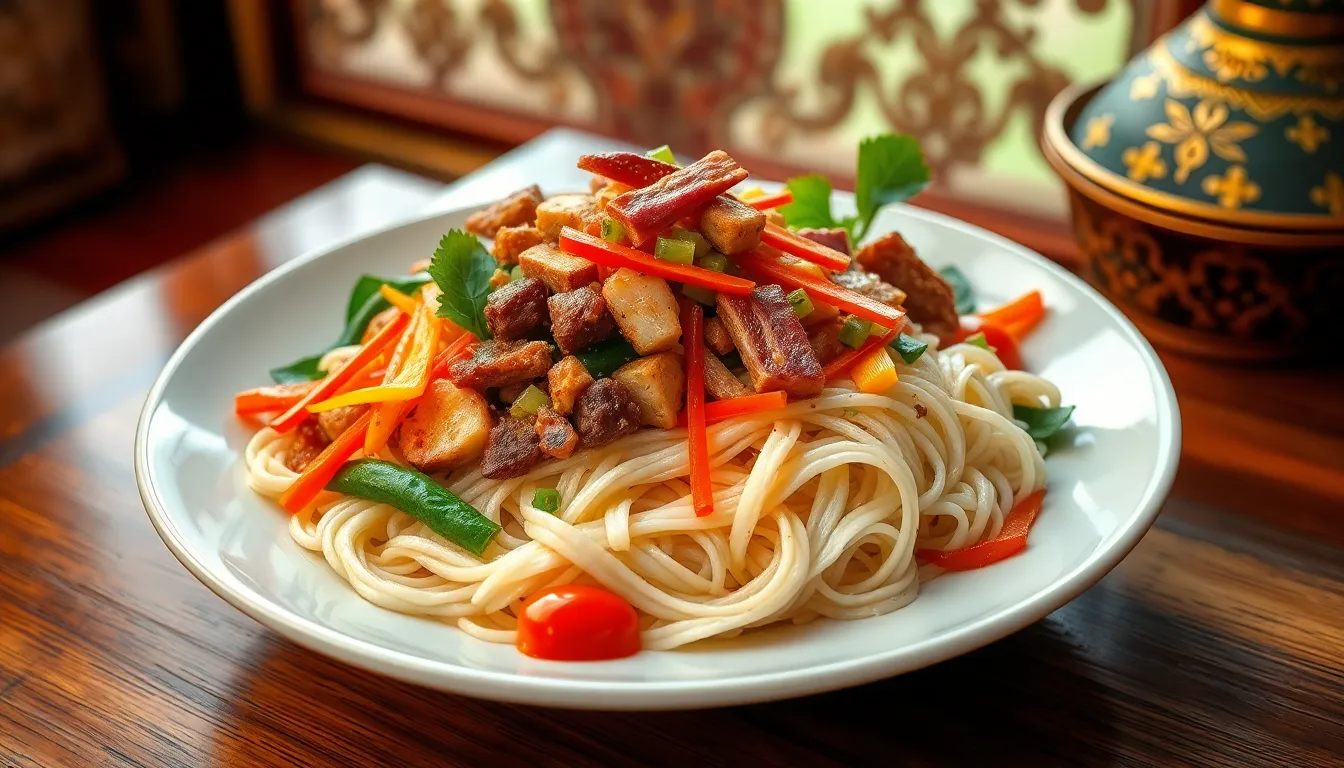In the vibrant streets of Myanmar, a culinary gem awaits those brave enough to explore its unique flavors: hingagyi. This delightful dish, often overshadowed by more famous counterparts, packs a punch that’s sure to make taste buds dance. Imagine biting into a rich, savory delight that feels like a warm hug from your grandma—if your grandma were a master chef with a penchant for bold spices!
Food Named Hingagyi in Myanmar
Hingagyi is a traditional dish from Myanmar, notable for its distinct and robust flavors. This dish combines various ingredients that contribute to its rich taste and texture. Common components include rice noodles, meat, and an array of spices, all harmoniously blended to create a unique culinary experience. Flavors range from savory to slightly spicy, enticing those who appreciate bold seasonings.
One defining aspect of hingagyi is its use of local herbs and aromatics, enhancing its character. Often, cooks incorporate garlic, onion, and ginger to achieve depth. Fresh vegetables also play a crucial role, adding both color and a healthy balance to the dish. Each bite reveals new layers of flavor that captivate the palate.
Culturally, hingagyi is more than just a meal; it signifies hospitality in Myanmar. Families often prepare this dish for gatherings and special occasions, showcasing culinary skills and traditions. Serving it hot, along with various accompaniments, creates a delightful dining experience.
Preparation techniques emphasize the importance of balance in cooking. Techniques like simmering or stir-frying ensure that flavors meld effectively. Innovating with ingredients and methods continues to evolve, allowing chefs to experiment while respecting tradition. Variants of hingagyi appear throughout the country, reflecting regional preferences and ingredient availability.
Understanding hingagyi opens a window into Myanmar’s rich culinary landscape. Those who try it discover a beloved dish that embodies the essence of local culture and tradition. An experience with hingagyi not only satisfies hunger but also connects individuals to Myanmar’s vibrant heritage.
History of Hingagyi

Hingagyi has deep roots in Myanmar’s culinary traditions, representing an important aspect of the nation’s food culture. Historical accounts indicate that this dish likely originated in local communities, where home cooks experimented with readily available ingredients.
Traditional Origins
Traditional origins of hingagyi trace back to the blending of various ethnic influences across Myanmar. Local farmers introduced rice noodles, while nomadic groups contributed unique meats and spices. Influence from neighboring countries also shaped the recipe, evolving it into a beloved dish across the nation. Various ethnic groups, including the Shan and Bamar, embraced hingagyi, each adding their distinct flair to its preparation. Adapting to regional tastes further established the dish as a staple in Myanmar’s culinary landscape.
Cultural Significance
Cultural significance of hingagyi extends beyond mere sustenance. This dish embodies hospitality, often served during celebrations and familial gatherings. Sharing hingagyi represents warmth and community, illustrating love and care in Myanmar’s social fabric. Preparing hingagyi is an art form, showcasing chefs’ skills and the importance of heritage. Festivals frequently feature this dish, allowing communities to bond over flavors and traditions. Through these connections, hingagyi not only highlights local culinary prowess but also strengthens cultural identity in Myanmar.
Ingredients in Hingagyi
Hingagyi showcases a harmonious blend of various ingredients that contribute to its rich flavor. Rice noodles serve as the base, providing a satisfying texture and bulk.
Key Components
Meats such as chicken or pork often take center stage, infusing the dish with savory protein. Aromatics like garlic, onion, and ginger enhance the flavor profile, creating depth. Fresh vegetables, including carrots and leafy greens, offer color and balance, ensuring a well-rounded meal. Local spices, especially chili powder and turmeric, create a vibrant, aromatic finish that elevates each bite.
Variations of Ingredients
Adaptations exist based on regional preferences, showcasing local resources. Different ethnic groups influence the choice of meat—some might prefer shrimp or tofu for a vegetarian twist. Ingredient ratios fluctuate, allowing each cook’s personal touch to shine through. The addition of nuts or seeds adds a unique crunch, while varying levels of spice cater to individual tastes. Each variation reflects a community’s distinct culinary heritage, making hingagyi a versatile dish enjoyed across Myanmar.
Preparation Methods
Hingagyi requires careful preparation to achieve its rich and savory profile. Skilled chefs often utilize a variety of cooking techniques to bring out the best flavors.
Cooking Techniques
Boiling noodles represents the first step in preparing hingagyi. After achieving the desired texture, cooks sauté garlic, onion, and ginger in oil to release their aromatic essence. Next, they add meat, such as chicken or pork, cooking until tender. Mixing in vegetables like carrots and leafy greens enhances both color and nutrition. Seasoning with local spices, particularly chili powder and turmeric, finishes off the dish, providing depth and vibrancy. Many cooks rely on traditional methods passed down through generations to maintain authenticity.
Serving Suggestions
Traditionally, hingagyi serves as a centerpiece at gatherings and celebrations. Hearty portions of the dish can sit in large bowls, encouraging communal sharing. Often, chefs garnish with fresh herbs and lime wedges, enhancing visual appeal and flavor. Pairing with sides like fried tofu or pickled vegetables adds variety to the meal. Serving alongside rice or flatbreads offers alternative options for guests, catering to different tastes and preferences. Celebrations in Myanmar highlight the experience, making hingagyi not just a meal but a reflection of warmth and hospitality.
Popularity and Regional Variations
Hingagyi enjoys popularity across Myanmar, celebrated for its robust flavors and comforting nature. Communities across various regions contribute to its distinct appeal.
Hingagyi Across Myanmar
Hingagyi varies significantly from one region to another. In the Shan state, cooks often include local vegetables and spices, enhancing the dish’s freshness. The Bamar people, on the other hand, might opt for different meats, such as chicken or pork, reflecting their culinary preferences. Each ethnic group adds a unique twist, resulting in a diverse range of flavors. Street vendors also serve hingagyi, making it easily accessible for locals and tourists alike. The versatility of hingagyi helps it suit diverse palates, ensuring its status as a beloved dish throughout the country.
Modern Adaptations
Modern adaptations of hingagyi embrace contemporary culinary trends while preserving traditional essence. Chefs experiment with ingredients, incorporating elements like seafood or plant-based proteins to cater to evolving dietary preferences. Alternative cooking methods, such as stir-frying, create quicker and lighter versions of the dish. Fusion variations have also emerged, combining hingagyi with global cuisines to attract a wider audience. Social media platforms further amplify these innovations, showcasing creative renditions. As a result, hingagyi continues to thrive, appealing to both traditionalists and new-age food enthusiasts.
Myanmar’s Rich Culinary
Hingagyi is more than just a dish; it’s a celebration of Myanmar’s rich culinary heritage. Its unique blend of flavors and textures showcases the artistry of local chefs while inviting everyone to experience the warmth of Myanmar’s hospitality. As it continues to evolve through modern adaptations and regional variations, hingagyi remains a beloved staple that brings people together. Whether enjoyed at home or from a street vendor, this dish offers a taste of tradition and community that resonates deeply within Myanmar’s social fabric. Exploring hingagyi not only satisfies the palate but also connects individuals to a vibrant cultural tapestry.

